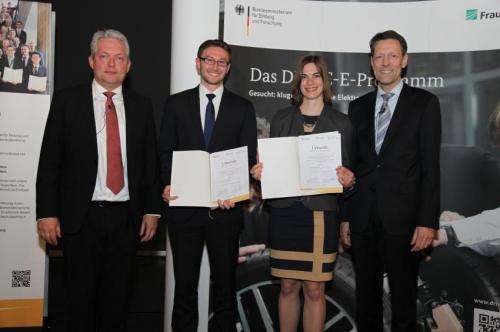Adequate design of electric vehicles

Which electric motor fits to which driving situation? This was the subject of the master's thesis written by Lisa Braun at the Karlsruhe Institute of Technology (KIT). Her studies might con-tribute to optimizing electric vehicles and to enhancing their acceptance and use. With her thesis, the young engineer has now won the first place of the 2014 Drive-E studies competition launched by the Federal Ministry of Education and Research and the Fraunhofer Society. The award was handed over by Dr. Georg Schütte, State Secretary of the BMBF, and Professor Alexander Verl, Member of the Board of Fraunhofer Society, in Stuttgart yesterday evening.
Until 2020, one million electric vehicles are planned to drive on German roads. This objective was defined by the Federal Govern-ment in its "National Development Plan for Electric Mobility". To enhance the acceptance and use of electric vehicles, their range has to be increased among others. This may be achieved by increasing the efficiency of the drive train. Lisa Braun, who studied electrical engineering and information technology at the KIT and specialized in electric mobility, analyzed the dependence of total efficiency of the drive train on the type of motor used in her master's thesis entitled "Fahrer- und fahrsituationsabhängige Bewertung unterschiedlicher Elektromotorkonzepte" (Driver- and driving situation-dependent assessment of various electric motor concepts). Her thesis is based on the following assumption: When the advantages of various types of motors are used specifically for various driving applications, the operating range of the machine is more important than maximum efficiency or maximum power density. "Depending on the application, that type of motor that reaches the highest efficiency over the complete operation period and optimally uses the limited energy of the battery would be chosen," the engineer explains.
Lisa Braun virtually tested and compared various electric motor concepts for selected everyday driving situations. Her tests covered permanently excited synchronous machines (PSM), the rotor of which contains a permanent magnet, externally excited synchronous machines (EESM), where the magnetic rotor field is generated by an electric current, and asynchronous machines (ASM). Contrary to synchronous machines, their ratio of motor speed to the frequency of supply voltage is not constant, but depends on the loading state of the machine. At the moment, the lightweight, compact PSM are used most frequently in electric vehicles. They reach the highest peak efficiency. However, total efficiency of the other two types is higher in particular at higher motor speeds.
Accordingly, the study of Lisa Braun revealed that PSM are far more efficient than EESM and ASM in urban traffic and during maneuvering in particular. With increasing speed, the efficiency of PSM decreases, while that of the other two types increases. In the high-speed range, EESM and ASM predominate. However, for a long measurement drive or a mixed driving cycle, the resulting deviations are rather small in spite of these significant differences. "From the technical point of view, no machine is to be preferred to the other, as long as the exact operation points over the entire lifecycle of the machines are not known. The machine type can therefore be selected according to other criteria," Lisa Braun explains.
According to Braun's thesis, personal driving profiles might be de-veloped from universally valid individual situations in the future. In this way, the design of the vehicles can be adapted optimally to the customers' needs. Lisa Braun wrote her master's thesis at the Insti-tute of Electrical Engineering (ETI) of KIT under the supervision of Professor Martin Doppelbauer, who holds the professorship for hybrid electric vehicles (HEV). Presently, she is working as a doctoral student at Siemens and is writing her thesis at KIT's Institute of Vehicle System Technology (FAST).
For the fifth time, the Drive-E studies award was granted by the Federal Ministry of Education and Research and the Fraunhofer Society to excellent, innovative theses of students in the area of electric mobility this year. In the category of "diploma and master's theses," Lisa Braun shares the first prize with Jonathan Jürgens from the University of Hanover. Both winners are granted an amount of EUR 4500. At the awards ceremony yesterday evening, April 3, at Mercedes-Benz Stuttgart, Dr. Dieter Zetsche, CEO of Daimler AG and Head of Mercedes-Benz Cars, presented the keynote speech about "The automobile energy turnaround: Status and perspectives of electric mobility."
Provided by Karlsruhe Institute of Technology




















